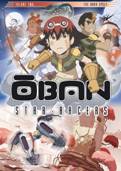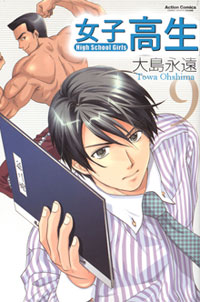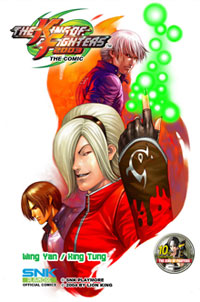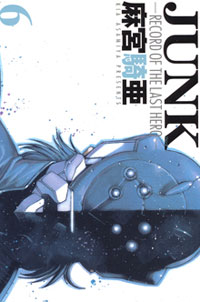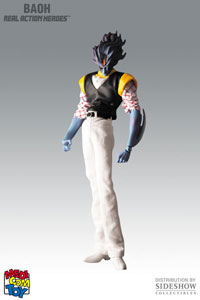 Logo handmade by Bannister
Column by Scott Green
Logo handmade by Bannister
Column by Scott Green
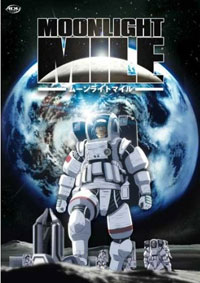
Anime Spotlight: Moonlight Mile Vol. 1: One Small Step Released by ADV Films
If Robert E. Howard wrote Planetes, it would be Moonlight Mile. Anyone who is not familiar with Planetes, track down the manga, released in North America by TOKYOPOP, and/or the anime, released in North America by Bandai Entertainment, for a brilliantly heartfelt work of speculative fiction, concerning orbital; debris removers and interplanetary exploration. Moonlight Mile touches on hard sci-fi, but at the same time, it is impossible to credit. What looks like concrete realism is quickly dispelled in favor of outrageous machismo in a tale of literally ball swinging men. Consequently, the appeal of the anime is narrow cast. Not only does the anime lean on an interest in the subject matter, it requires the viewer to embrace, or at least accept a Pokemon "I'll be the best approach" to men living their lives. As such, it's all about admiring achievement. Conventional morality in compassion have little place among heroes who are focused on the next notch on their belt. Intercourse plays a role as atmosphere. It's a non-titillating transition between scenes that establishes that the heroes are the kind of guy who always finds a woman to sleep with, regardless of where he is or what he is doing. While there is an aura of manliness around the Right Stuff space race, that reality has nothing on Moonlight Mile's seinen approach to the subject. Given its straight faced presentation of the outrageous, if you can't take Moonlight Mile ironically, then it at least has to be approach in a detached fashion. Junichi Sato's (Princess Tutu, Kaleido Star) 1996 OVA Magic Users club was a trivial, but often well animated and clever comedy about the underdogs in a high school clique of wannabe wizards. In its opening shots a silent, cyclopean alien bell moved towards Earth's atmosphere, taking out a number of satellites in the descent, unleashing noiseless destruction. Media Blasters eventually released this on DVD, but this was a fun title to screen for people in the old tape trader days. You'd show this to a room full of people and inevitably, someone would start questioning if there was a problem with the duped VHS until realization dawned across the room: oh, this goofy comedy was suggesting that space was silent. Moonlight Mile opens on a barren lunar landscape. Fatima Toure Gutu is in the throws of a marathon moon run. She was part of the Second Lunar Expitition. Her spider lift crashed. Rescuers were twelve hours away. She had five hours of air left. So, she's running to an emergency supplies drop, and she tumbles into a crater. Servos sound as a metallic foot pounds into the dusty surface. This limb is attached to the first point of a squad of robot soldiers, who immediately train their weapons on Fatima. As she stands, one jets towards her, then levels her with a kick. A transport is heard hovering to the site. A man lands. There's a "scree" noise has he shines a laser sight onto Fatima, and she screams. Ostensibly, this is politically informed hard sci-fi, concerning a second moon race to claim stakes in a gold rush for lunar recourses. It's not just the noise effects in this introductory scene that disabuses one of the notion that this is strict sci-fi, it's the ritual and sadism for dramatic effect. Why is a robot kicking a woman down when she has no chance of escape? Moonlight Mile is packed with details, but their accuracy is akin to the accuracy of details in a Kazuo Koike work. The original manga ran in Big Comic Superior, home of Azumi, Buronson / Ryoichi Ikegami's Heat and Strain and Sho Fumimura / Ikegami's Sanctuary. Like many of the Buronson/Koike/Ikegami works, Moonlight Mile is a fable of manliness set in an elaborate, yet transparent lie. A critical adult is not going to credit the world of Strain, where a professional killer charges five dollars a hit, then in refusing to kill the mother of a child prostitute he starts knocking down a geopolitical house of cards. Yet, given the intricacies of the plot and the detailed mechanics of the world and its events, the outrageous yarn becomes involving. After its prologue, the anime cuts to Goro Saruwatari and Lostman as the mountaineering adventurers climb their final challenge: Everest. They spot a French party as the group is burried by an avalanche. After rescuing "Snow White" they take her to base camp and smoke as she desperately sucks oxygen. She introducers herself and morns her dearly departed husband, but when she's dead it's "Snow White's" wedding ring they put on the summit as they look up and spot the International Space Station. From here, the anime concerns itself with these two ubermensches as they work their way into the next adventure: space. Lostman enlists as a fighter pilot. Saruwatari returns to Japan and begins mastering the field of heavy industrial construction. Impressive physically, impressive mentally, and as demonstrated in quick cuts to sex scenes, always bedding one woman or another, actually, "bedding" isn't really the right word, since it is often in cranes, bathroom stalls or aircraft carriers, they represent a primitive ideal, the favorite son of evolution, an example that culture either aspires to or is wary of. Adding to the Conan-esque quality to the story is that the anime is packed with racial stereotypes, both in the visual and story design. Physical features and cultures are accentuated to laughable degrees. For every instance where this is handled smartly, such as the ironic resolution to a Middle East excursion, there's a sea of faces and attitudes that seem to be penned from an outdated mindset. Whether it is facts or attitudes, Moonlight Mile will always give a critical viewer plenty in which to find fault. Rejecting this is a reasonable reaction, but finding irony or appreciating distinctive spirit are also options that the anime affords.

Anime Spotlight: Project Blue Earth SOS Vol. 1: Invasion! Released by ADV Films
Project Blue Earth SOS is incredibly smart or accidentally provocative. Either way, I've thought about the implications of this Tom Swift versus the ID4 aliens more than I have most recent anime. The anime is retroactive sci-fi, reflecting the world of the millennium as imagined by some one in the 1960's. As such, it portrays an uncynical approach to science and technology as forces that can raise humanity and save it. Yet, a decade after the anime is supposed to have taken place, the anime feels post-post-irony. Alien saucers are blowing up cities and it seems like the anime is willfully staging the devastation in the context of a pitched adventure. It's Hollywood and not reality. Similarly, a surfacing object capsizes a Japanese fishing vessel, and events like the Ehime Maru disaster do not seem directly referenced. Maybe this sort of detached adventure that looks a bit like real world concerns, but never goes so far as to engage real politics, is supposed to provoke a cold, clinical view of the handling of disasters. Certainly, with the good guys who unveil their secret organization to protect humanity from alien invaders, there is something fascistic in the way that the noble white coats take charge. In 21st century thinking, one assumes that the promise "I've secretly prepared to help you in this eventuality" comes with a swerve in part II. In 1995 the military was testing a plane that would be able to fly around the world with the advanced G-Reactive propulsion system. Mid-test, rainbow beams began bombarding the craft, and it mysteriously disappeared. Five years later a renewed string of incidents concerning G-Reactive powered transportation craft set industrial heir boy genius Billy Kimura and independent boy genius Penny Carter on the case of the mysterious invaders responsible for these disappearances. Rivals Billy and Penny, along with Penny's dog Washington find aid from Billy's childhood friend Lotta Brest, daughter of the renowned scientist Doctor Brest (yes, this is funny, and ironic given that Lotta is a kid, largely in a genuine sense and not the duplicitous moe fashion), Lotta's tutor/secret agent Emily, and an airforce captain whose protégé piloted the plane that disappeared in 1995. Project Blue Earth SOS is fast and free with its references. It starts with a base layer of 60's tech and 60's sci-fi. Camera crews are recording to film. Radios look like they're using transistors. Everything is large, tactile and working with visible moving parts. The cars might not be flying, but they are hovering. Then, there's a layer of media reference. Without tripping the in-joke wink parody, without the premature satisfaction of borrowing from the already-successful, the anime pulls from Japanese traditions such as tokusatsu special effects movies and its anime parallels such as Gatchaman, and the anime pulls immediately recognizable components from Western works whether it's James Bond, Men in Black or, of course, Independence Day. Project Blue Earth SOS was directed by Tensai Okamura, known for his work on Wolf's Rain, but also worth knowing for his contributions to Cowboy Bebop, and in the Stink Bomb short from Memories. He's done retro before with the anime adaptation of Ishinomori's Kikaider. Here, he seems not to want to intrude. There's a graceful fury to the sci-fi fighter versus saucer dog fights, there's a scale to the weapons of mass destruction attacks, but whether it's ray guns or automobile gadgets, he's projecting ideas onto anime and not trying to elaborate on those ideas. Especially compared to the more spirited parts of the recent anime adaptation of Ishinomori's 009-1 or Rintaro's adaptation of Tezuka's Metropolis, Okamura is creating an original work that looks like a strictly faithful adaptation. Project Blue Earth SOS always creates the right impression. When Billy and Penny are moving and reacting, their quick thinking is evident. At the same time, when there is some genre trope, especially one that is familiar to anime such as a tentacle assault, some creativity or innovation would have been welcome. It could very well be over-thinking the series, but watching it with a critical modern eye, questions are raised: "is there another shoe waiting to drop?" Which 'good guy' isn't?" "Which 'bad guy' isn't?" If things are how they appear, there are still troubling implications concerning cabals of scientists and politicians grabbing power and using that power to shepherd unquestioning populations.
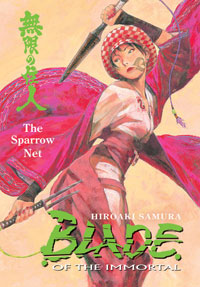
Manga Spotlight: Blade of the Immortal Volume 18: The Sparrow Net by Hiroaki Samura Released by Dark Horse Manga
Almost 15 years into the run of the manga, Blade of the Immortal is being adapted into an anime series. An anime fan's excitement is going to be informed by their faith in the studio handling the project: Bee Train (Noir, .hack, Tsubasa Chronicle), but any reader of the manga has to wonder how any studio would be able to handle Hiroaki Samura's approach to his tale of a samurai with acquired immortality. On one hand, there is the particular mix of media that he uses: charcoal, pencils, particular inking techniques. Then, there are his sensibilities. The recent Cat Eyed Boy recommendation touches on the ero guro nansensu (erotic, grotesque, nonsense/absurd) movement/tradition. Samura has demonstrated a fascination with these themes. His recent art book Hitodenasi no Koi (The Love of the Brute) explicitly dealt with sexualized torture imagery. Blade of the Immortal has consistently worked with studying violence, depicting it and discussing its motivations and implications. Like recently on DVD film Bonnie and Clyde, much of this has been engaging the legend and reestablishing its barbs. Yet, the recently released segment of Blade of the Immortal, fan-named the "Prison Arcs" has gone in a different direction. Manji, the immortal swordsman, and Rin, the young woman who was to have used Manji as an instrument of revenge in a mission that was to work towards Manji's redemption have been separated. The Rin half of this plot line is a bit closer to traditional, expected Blade of the Immortal, but not by much. Rin finds herself travelling with Doa, a troubled, p;athologically violent younger woman who identifies herself with Japan's native Ainu population and her hulking companion Isaku. Doa and Isaku are crammed with problematic secrets, some of which Rin knows/suspects, others of which she could not possibly guess. The Doa/Isaku story furthers Samura's anachronistic punk narrative in Blade of the Immortal. They're radical individuals whose existence flaunts a rebelliousness against the strict regimentation of society. Samura twists this between a fight the law comedy and real consequence. The back and forth pendulum between ball breaking humor and desperation plays out with amazingly deftness. The Manji part of this phase of the Blade of the Immortal stands out as the antithesis of the wondering swordsman chambara that served as a model for the manga. Manji is helpless and immobile, chained in a prison as experiments are performed on him. In the "Manji" mailing list "madame_manga" posted a thesis about how this part of Blade of the Immortal serves as a discussion of the World War II history of the Imperial Japanese Army medical research project Unit 731. (A topic that is also engaged in by Kurosagi Corpse Delivery Service). In the middle 1980s (when Hiroaki Samura was a teenager) revelations about Unit 731 began to emerge, and testimony by its former personnel shocked the nation. Mass graves filled with victims' remains and severed body parts were uncovered in the middle of Tokyo during construction digs. Especially since the 1989 death of Emperor Hirohito, who almost certainly personally signed authorizations for these atrocities, elderly veterans of the unit have continued to come forward with confessions and accusations, and more evidence of the unit's activities keeps emerging. Recently another set of mass graves was unearthed, returning Unit 731 to the headlines. The human subjects were referred to as "logs of wood" instead of people. In this story, it is otters. Ayame Burando, a doctor condemned for his use of "ranpo," Dutch, Western medicine is on the chopping block to unlock the secret of immortality. He has Manji to work with and he has a supply of prisoner test subjects. At first the moral circumstances are too much for him to handle. Then, he begins to see the prisoners as the otters that he dissected in his youth. Rooms of chained men are affixed with hoods bearing crudely drawn animal faces and Burando goes to work. Even if it's been foreshadowed for volumes, even if Samura offsets it with the inclusion of a hapless pair Tweddle-dee and Tweddle-dum low rent bumblers on the scene, the magnitude of this crime becomes haunting. Demonstrating that he's a masterful writer in addition to a masterful illustrator, Samura finds a way to couch the larger scope of Blade of the Immortal in terms of this mindset of asserting ones own identity and removing the identity of others. The man who was presented as the chief antagonist of Blade of the Immortal and a sometimes ally third party sattle up to each other in a bar discussing the obsession with male heirs and passing along ambitions from parent to child. Kudos to translator Dana Lewis. It's a complex scene in which two people are concealing their identities, making pointed comments, drinking and at the same time connecting with each other. The modified voice of the two parties as well as the context of the conversation matters, and Lewis conveys all that distinction. Fans of early Blade of the Immortal's formula of weird weapons and weird deaths might lament that the series has departed from tracking down bizarre people and fighting them under morally complex circumstances. Yet, as demonstrated by the Unit 731 issue, Samura has taken his exploration of violence into a new, treacherous territory. Early in the manga, Manji fought perverts, people like serial killer, self-styled poet Sabato Kuroi ("Black Sabbath") who mounted the heads of two women that he "loved" on his shoulders. Then, he fought nihilists. There are still a few antagonists who offer unequivipable justification for removal from the face of the earth; the sadist murderer Shira is presumably waiting to make his reappearance and he's a rabid figure calling to be put down, but for the most part, the straw man antagonists are out of the picture. Samura doesn't look to justify these revolutionaries, twitchy stabbers, authoritarian strongmen with compartmentalized lives and complicit tramplers on human rights in the eyes of the reader. Instead, Samura offers a compelling exploration for how these people justify their actions to themselves.

Manhwa Spotlight: Shaman Warrior Volume 6 By Park Joong-Ki Released by Dark Horse Manhwa
Thereare plenty of manga/manhwa titles that I would like more people to read. If I want to dampen my mood, I think about how pitch black horror comedy Octopus Girl was aborted or how only three volumes of Junji Ito's Museum of Terror made it to market. Talking to About:Manga at Sakura Con, Dark Horse's Carl Horn lamented the difficulty faced by mature manga. Horn sited Satsuma Gishiden, "Hiroshi Hirata has created one of the best samurai manga, ever. But we couldn't continue publishing it after volume 3, because it wasn't selling." In the case of a work like Satsuma Gishiden, I can see the challenge. It wasn't something published in Garo. It wasn't as difficult as a Yoshiharu Tsuge work, but it was dense, it was bleak, and it did deal with unrelenting hardship. As much as the power and depth of manga is praised, escapism is what sells. I'm not enamored with the idea that I don't get to read more Satsuma Gishiden, but I can also see why the story of proud samurai, the product of generations of martial discipline, grinding, sacrificing and dying in a public works project is a license to print money in reverse. (Publisher Mike Richardson weighs in here_ I'd love to see more successful diversity in North American manga. Specifically, I'd love to see horror manga do well. Yet, putting on my video store clerk "you'd like.." hat, rather than my jaded critic "I'd like you to like..." hat, I'd say "check out Shaman Warrior." There is no reason why a guy should not read it. If I'd pick a manga/manhwa to give one of my 20+ year old brothers, buddies or co-workers to read, I'd pick Shaman Warrior. Having taken the time to arrange and ready the pieces, Shaman Warrior is now in full swing for volume six. There is honesty in the portrayal of the characters. The manwha has shown the heroes earning their abilities through sweat and blood, acquiring their motivation in tragedy. Yet, even with the politics and twists, its plot does not transcend stock familiarity. Shaman Warrior could get away with far worse, but the title is hardly a work to read for its ideas. Initially, what stood out about Shaman Warrior was that its action made sense. A reasonably able comic illustrator can use the time lapse between one panel and the next to accommodate for just about anything. The climax of Sin-Ichi Hiromoto's adaptation of Return of the Jedi works like this: The Emperor is cooking Luke Skywalker with lightening; Vader is off to the side somewhere between the two The page ends with the a close up of the cackling face of the Emperor The next set of pages is a wordless spread that stares into the eyes of Vader's helmet The large first panel of the next page is Vader with the Emperor lifted over his head Initially I wrote "Vader lifting the Emperor over his head", but I edited that. The action of the lift is implied, not illustrated. In between those panels, Vader turned, closed the distance between himself and the Emperor, then managed to lift him. The manga never shows that happen, but the reader can safely assume it is the case. For any comic illustrator, this is a necessity and a license. They're not choreographing a movie. They don't need to block out the fight with strict logic. In contrast, space and position always matter in Joong-Ki's work. If some one is leading with their left side, they are going to throw a jab with the left, throw a cross with their right and move their torso accordingly, or advance forward. Yaki, the young woman on the cover image above, is taking out a number of guards. One gets his neck snapped, but a second can see her over his shoulder and starts turning with a sword backhand. Before he can get his body around and throw the swing, Yaki checks it with her left palm to his wrist and cuts his throat with the blade in her right. Joong-Ki is still utilizing that space between panels. There's a transition from check to throat gushing blood. The difference is that there is an honest accounting between panels. The abilities of these characters are amazing, but there's is still, always, a credible path between what is happening in one panel and the next. Then, in volume three, I said "without hyperbole: Shaman Warrior holds its own against martial arts action from any medium." What prompted this was the fights featuring the character Batu. This ssireum wrestler, trained in the wasteland Butcher camps is modeled after the strong but not too bright sidekick, yet due to the events of the manhwa, he is frequently thrust into the forefront of the story. Volume three took this human freight train and showcased his arsenal of unarmed techniques. The physicality of this guy and a bigger, almost as skilled opponent going through the range of a fight, trading punches, wrestling, twisting joints and reaching for chokes, rival the impression of live action. There are comics where explosions bullets and mean little, but every punch and arm bar in Shaman Warrior looks like some one is succeeding at hurting a foe. Volume six of Shaman Warrior marks a point where all of its primary characters are trained, prepared and ready to fight for real. Through a flashback, the volume features more of Batu's unarmed, mixed martial arts, but here I'm going to take the Shaman Warrior as MMA analogy in a slightly different direction. Recently, san shou (a mix of striking and throws) fighter Cung Le defeated Frank Shamrock, a notorious MMA veteran and innovator who left the sport for a decade. A case can be made that both of these fighters have deficiencies or unproven potential that makes the bout less significant than a fight between two established, competitive MMA fighters might be. Yet, what made the fight thrilling is that Cung Le took a style that was exotic and made it look effective. There are accepted parameters for what is believed to be essential in MMA: boxing and Muay Thai kicks for striking while standing. Wrestling for transitions. Jujitsu locks and chokes or punching (ground and pound) when the opponent is down. Cung Le got into the ring with someone who is known to be a dangerous fighter and begun doing side kicks, high kicks to the head, arced crescent kicks and so on, and it was shown to work. The latter half of Shaman Warrior volume 6 has people leaping over walls, running across roof tops, fighting with two swords, jump kicking... It's exotic as a wuxia movie. And it's flashy. After checking a swords thrust with a knee to the forearm, why not follow it up with a flip kick? Yet, the nitty-gritty detail, the fact that move to move the fights follow an establish logic, and that the fact the fights are sustained page after page with a logical beginning middle and end, makes it all look effective. If you're a fight fan, this is the comic to read.
Anime on Cartoon Network
a geek by any other name notes that Media Blasters' John Sirabella indicated on Anime on DVD's forum that Production I.G's Seirei no Moribito will still air on Cartoon Network as it was originally planned prior to Geneon’s demise. Speaking on Media Blasters release of Geneon titles, Sirabella also notes that he has two more un-announced titles. According to Sirabella, Media Blasters has little interest in Geneon's partially-released series. After airing the first block of FUNimation's localization of One Piece, Cartoon Network has pulled the anime in favor of the new Bakugan. The network has indicated that they have no plans to bring One Piece back in their immediate future. The Adult Swim anime block is limiting its anime programming to Saturday night with 12:00- Shin-Chan 12:30- Bleach 01:00- Death Note 01:30- Code Geass Twenty-six new episodes of the comedy series Shin chan will debut on Cartoon Network's Adult Swim on Friday, April 4, 2008. The series will air Fridays at 12:30 a.m. and 3:30 am ET/PT. The next set of episodes are: Episode 27 – Shin Wars, premieres April 4 “Shin Wars: Episode IV: A Poo Hope” – A long time ago, in a galaxy far, far away, Darth Bader has kidnapped Princess Labia, only in this version she’s not hot! Now it’s up to Any-Wan Canblowme and young Puke Skypooper to save the princess, and first they’ll need a ship… But it’s been towed! Your light rod is weak and flaccid, old man. Wait, that’s not what happens! “Shin Wars: Episode V: The Empire Likes Sprack” – Now was it Lord Bader or Master Bader? Either way, the helmet head is feeling a great disturbance in his shorts! Meanwhile, Puke Skypooper and Princess Labia find themselves the reluctant rescuers of oppressed semi-cute woodland creatures… Great, we’re pandering to a younger demographic! “Shin Wars: Episode VI: Re-turd of the Hentai” – As our heroes continue their laborious climb up to the Meth Star, the woodland insurgents prepare to take on the High Fighters. And after the surprise return of Any-Wan Canblowme, young Skypooper faces off against Darth Bader one last time! Just what we need, another glowing cock fight… Remember, size matters not Master Puke! Episode 28 – The Stalker Song, premieres April 11 “Kindergarten Pop” – Hiro’s called in a bomb threat and is enjoying his day off from work when Mitzi remembers that it’s parent’s day at the school. Reminded of all the hot young moms, Hiro jumps at the chance to put his family first! But things progress rapidly from bad to worse, jump started with an essay Shin wrote about his father! “He comes home drunk, his life is lame…” “The Secret Life of Georgie” – Like all Republicans, Georgie’s harboring a secret! The youth is desperate for a cardboard reproduction of Yaz from the TV series Heiressz. What lengths will he go to in order to get his hands on the prize? And can he do it while keeping his shameful love for such girlish tripe from his friends? Oh, to have so much money and yet not be able to buy your heart’s greatest desire… How cruel! “Action Bastard Says, ‘Give Yourself the Shaft!’” – It’s another evening at the Nohara house, but Mitzi’s in an awfully good mood! Could it have anything to do with the Action Bastard Vibrating Bastard Shaft that Shin won at the store that day? Everyone seems to have a different use for it, but they’re all getting off! That is, until Shin tries it out on Hiro… Watch out: Things get really messy! And fast! Episode 29 – Double Fried Flavor!, premieres April 18 “The Drinky Hiro Show!” – It’s after hours and Hiro’s home… Drunk! After amusing himself with his sleeping family, the wasted wastrel decides it’s time for a midnight snack. Mmm! Steak pancakes! Alerted by the danger to his food supply, Shin is soon drafted in the cause. Gross quickly dissolves into disgusting. Hiro, that smear better be chocolate mashed potatoes! “Trading Faces!” – Take one worn out mother and add one boy, desperately dashing for the potty, and you’ve got a recipe for disaster! Shin and Mitzi find their roles reversed… Literally! And their first problem: Plumbing! You’re sure you know how to use that thing, Mom? Hmm, it can’t be that hard! Uh oh, Shin, I need you to breastfeed your little sister! “Trading Faces! Part 2!” – Things only get weirder as Hiro comes home… This is not what was meant by role playing! Hima’s not the only one freaked out as Mitzi/Shin cares for her/his daughter/sister at school, while back at the house Shin/Mitzi is getting busy stuffing face. Boy, this is getting confusing! And when Shin/Mitzi leaves the house against orders, embarrassment will be redefined for the neighborhood! Funimation Entertainment will also release the first Shin chan DVD on May 13. On the non-anime Cartoon Network front, TV Guide reports a Batman: The Brave and the Bold is in the works. Guest stars on slate include Green Arrow, Blue Beetle, Green Lantern and Aquaman. Rob Sorcher, Cartoon Net's chief content officer, says The Brave and the Bold will be "equal doses of comedy and high stakes." New episodes of The Venture Bros. premiere June 1st
Anime in the UK
Otaku News HMV is offering an exclusive deal on the Mysterious Cities of Gold DVD Box set, which is in stock on their website. The official release date for this DVD is 23rd June 2008, the shop current has it. Anime on DVD reports that MVM Entertainment will also be releasing Gravitation. The first volume arrives on 07/07/2008 for £15.99.
Anime on Blu-ray
Via Anime on DVD A Japanese Fullmetal Panic Blu-ray Box has been announced for a 06/27/2008 release for 35,112 yen. CD Freaks has piece on how Blu-ray is picking up steam in Japan. While Blu-ray account for 1.3% of the market back in September of last year, in February it accounted for near 19% of the overall home video market share.
Manga for FCBD Promotion
Pop Culture Shock collects information about the manga offered through the Free Comic Book Day promotion. The following will be available at local comic shops Saturday May 3rd, 2008. Gold Sponsor VIZ Media is offering a special 32-page edition of Shonen Jump highlighting Bleach, Naruto, and Slam Dunk. Antarctic Press, which will give away copies of Rod Espinosa’s Neotopia; Del Rey, which will distribute a sampler featuring In Odd We Trust, the highly anticipated Dean Koontz/Queenie Chan project; Drawn & Quarterly, which will circulate a 24-page sampler highlighting their big 2008 manga releases, Yoshihiro Tatsumi’s Good-Bye and Seiichi Hayashi’s Red Colored Elegy; and Yen Press, which will be unveiling a short excerpt from James Patterson’s Maximum Ride.
GDH Implements an Open-Pricing For Online Distribution
GDH K.K. has announced that it will use an open-pricing model as one of the options in the online distribution of The Tower of Druaga -the Aegis of URUK- and BLASSREITER, two new animated series produced by its main production subsidiary GONZO K.K. The two new titles will be available online for viewers overseas on the same day of their Japanese TV broadcast. With the launch of this new service in April, GDH will test an open-pricing system with one of the distribution websites, Crunchyroll.com. This system allows users to determine the price they pay in exchange for downloading the high quality animated episodes. This model is designed to services the more market-oriented direction developing in online distribution. And by allowing the users to determine the value of the product and make their voices be heard, GDH derives valuable feedback directly from consumers. Popular titles could generate high offers, with revenues going back to the content providers to offset the costs of distribution and development of future projects. Crunchyroll aims to offer to its community a legal alternative to illegal file-sharing and downloading, and at the same time establish online distribution business models such as ad-supported streaming and open pricing for download, in which content providers are able to generate revenue from the market. As the first content holder to embrace a "pay-what-you-want" model, GDH will study its feasibility to advocate it as a key to further cultivate the Japanese content business backed up by anime fans all over the world.
Otakon To Host JAM Project, Feature Original Madhouse Intro
Otakon, held 8-10 August 2008 at the Baltimore Convention Center and First Mariner Arena in Baltimore, Maryland announced that Japanese rock act JAM Project will be performing at the convention. A “supergroup” currently consisting of Hironobu Kageyama, Rica Matsumoto, Masaaki Endoh, Hiroshi Kitadani, Masami Okui, and Yoshiki Fukuyama, JAM Project (“Japan Animation song Makers”) was formed in 2000 and is best known for catchy theme songs for popular TV anime, video games, and live action “tokusatsu” (special effects) television shows. Perhaps their most popular association is with the Super Robot Wars series of video games. Hironobu Kageyama is known as “the prince of anime songs”, and is associated with at least 17 popular shows including Super Dimension Cavalry Southern Cross, Dragon Ball Z, various Transformers shows, Sonic X, Shin Getter Robo, M.D. Geist, and Saint Seiya (known in the US as Knights of the Zodiac). He has recorded nearly 50 songs for the massively popular Dragon Ball Z anime, earning him the nickname “Mr DBZ”. Rica Matsumoto is a popular voice actress and singer and one of the founding members of JAM Project. Her voice is perhaps best known as that of Satoshi (Ash Ketchum) in the hit Pokémon, but she has voiced dozens of roles, most often giving voice to young boys. Masaaki Endoh is a singer/songwriter whose work can be heard in King of Braves GaoGaiGar, Daigunder, and Bakuryuu Sentai Abaranger – known in the US as Power Rangers: Dino Thunder. Hiroshi Kitadani is a musician perhaps best known for “We Are!”, the main theme of the immensely successful One Piece. He has also been a member of Lapis Lazuli and Stagger. Masami Okui is an extremely prolific performer, featured in over 50 singles and 17 albums. Her theme song work (with JAM Project, solo, or with other groups) includes an impressive list of titles: Revolutionary Girl Utena, Slayers, Sorcerer Hunters, Di Gi Charact, Magic User’s Club, Jungle de Ikou, and Yu-Gi-Oh! Duel Monsters. Yoshiki Fukuyama is a guitarist and singer/songwriter who became famous as the singing voice of lead character Basara Nekki on the hit show Macross 7. He and his wife, Kyoko, often work as a team, with Yoshiki composing the music and his wife the lyrics. Fukuyama has also been involved with several respected side projects over the years, including the band Humming Bird. Their appearance in Baltimore will be JAM Project’s debut performance in the United States. According to Anime News Network, Haré+Guu's Tsutomu Mizushima will direct a 90 second Madhouse produced short to open the 15th annual Otakon convention.
Dark Horse Announces Dayan
Dark Horse will be releasing Akido Ikeda's international sensation Dayan (Dai-On) in North America. The first four volumes--Dayan's Birthday, Thursday Rainy Party, White Eurocka, and Chibikuro Party--will be released in the states on April 23, 2008, for a retail price of $9.95. The mischievous cat Dayan has spawned over thirty books, a theme park, museums, and stores dedicated entirely to the fictional world where he resides, Wachifield. From Dark Horse's description: Wachifield is an enchanted, anthropomorphic world conceived by author Akiko Ikeda during her childhood--a mystical universe where plants and animals talk, and with their words teach classic tales of wisdom played out in fun, heartwarming scenes and through vivid artwork. Her whimsical and timeless illustrations have garnered international recognition, and her intricate world continues to expand due to her nearly limitless imagination. Dayan, the central character and favorite resident of the town of Tachiel, is an adventurous cat whose curiosity often leads him into fantastical adventures. Luckily, he has the support and help of his friends, who include Marcy the dependable bunny, and the hard-drinking alligator Nbah. Follow Dayan and his courageous cronies as they outwit a coven of angry witches, a devilish forest nymph, and even their own shadows! Along the way they manage to make new friends, experience the snow magic of the Eurocka festival, and make a rainy Thursday into an event to remember! Though originally written for children, adults and fans of Japanese culture will love these stories for their deceptively complex narrative, darker undertones, and alcoholic alligators.
Second Half of Oban Star Racers Scheduled
Shout! Factory will be releasing the second half of Oban Star Racers in a 13 episode set on May 20, 2008 for $19.99. The satellite tournament on Alwas has been completed, and Molly and the crew of the Whizzing Arrow have qualified to compete on Oban for the mysterious Ultimate Prize. Can young Molly outrun the competition, save Earth and win the power to bring her mother back to life? See this epic anime adventure which features spectacular mixed-media, combining 2D Japanese-animated characters with 3D animated ships and races. To maintain the quality and originality of this project, creator and animator Savin Yeatman-Eiffel spent nine years on a personal mission to complete this series with no influence from outside investors. The set will be presented uncut in 5.1 audio. Special Features Include: The Making Of Oban Star-Racers (Part Two) Star-Racer Profiles Concept Art Original MIPCOM Presentation Full Opening Title Sequence
TOKYOPOP Light Novel News
a geek by any other name's report on TOKYOPOP's Sakura Con blog noted that TOKYOPOP has put the second Kino no Tabi/Kino's Journy novel on indefinate hiatus due to trouble with their licensor. The release of more Slayers novels is held up by low sales. OEL title Bizhenghast is getting a novelization.
News DrMaster Releases
DrMaster Publications has announced that High School Girls vol. 9, the final volume of the series by Towa Ohshima, The King of Fighters 2003 vol. 4 by Wing Yan & King Tung, and Junk - Record of the Last Hero vol. 6 by Kia Asamiya, are all available now. High School Girls vol. 9 The end is finally here! The crazy Okinawan school trip approaches its end in this final volume of High School Girls. Eriko and her friends are up to their usual antics terrorizing the teachers, starting pillow fights, buying up weird Okinawan souvenirs for their friends and families, and having late night sleepovers snacking and reminiscing about their hilariously silly pasts. Prepare to laugh your socks off in this awesomely hysterical and side-splitting conclusion to the High School Girls series!The King of Fighters 2003 vol. 4 The King of Fighters 2003 series returns with more explosive kicks and punches that will blow your mind! The 10th King of Fighters semi-finals kicks off with Team K' vs. The High School Girls Team on top of the zooming "Highway Star Express." However, their match is unexpectedly interrupted by the former leader of NESTS' research department, the Phantom Pain-Kirameki Kannaduki, who suddenly attacks K'. What will happen to K'...? On the other end of the world, on a sailboat on the Nile River, the second battle of the semi-finals is taking place - Hero Team vs. Wolf Team. Shen-Woo vs.Terry Bogard begin the incredible battle between the two highly-skilled teams. Both fighters pull out all they have for battle, and despite the unexpected result, the sensational combat touches the whole world. Junk - Record of the Last Hero vol. 6 Hiro goes back to school to begin a fresh start in his life... or so he thought, until his sexy new JUNK counselor becomes his new homeroom teacher! As the third JUNK's terror escalates, a new and more powerful JUNK sent by JUNK Systems appears and is set on punishing the third JUNK. While a cult called Koufukukai reaches out to the fear ridden citizens of Tokyo with sinister intentions behind their "goodwill." High School Girls vol. 9, The King of Fighters vol. 4, and Junk – Record of the Last Hero vol. 6 are AVAILABLE NOW! High School Girls and Junk – Record of the Last Hero are each priced at $9.95, and The King of Fighters is fully colored and priced at $13.95.
Figures News
Sideshow has 20 Medicom Toy 12" RAH Baoh figures, based on the manga by Jojo's Bizarre Adventure creator Hirohiko Araki, in stockGo Hero has a third set of prototype photos from their Buck Rogers figure. A look at Gurren Lagann trading figures Glow in the dark Squirm Revoltech cherry blossum viewing
Worth Checking Out
AnimEigo is taking pre-orders for their release of Yawara, an adaptation of the Naoki Urasawa (Monster, Master Keaton) manga about a high school girl raised by her grandfather to participate in the Olympic judo competition. Afuganisu-tan, the 4 panel comic strip account of the history of Afghanistan is making the rounds again. See it here or hereA trailer for roduction I.G and Masamune Shirow's RD Senno Chosashitsu/Real Drive is online. Alt Japan looks at the history of the term otaku Otaku USA podcast 2. There is a preview of the next issue here. Also, check out Macias' Message From Space roll. Anime Pulse has posted a number of recordings and interviews from Sakura Con, including Ronald Kelts, author of Japanamerica Rahxephon's Yutaka Izubuchi State of the Industry with Derek Stephen Prince (Voice Actor), Roland Kelts (Author of Japanamerica) and Lilian Diaz-Przbyl (Editor from TOKYOPOP) Twitch notes that season three of Ani Kuri, with shorts by Satochi Kon (Paprika), Micahel Arias (Tekkon Kinkreet), and Makoto Shinkai (5 Cm Per Second) are on the official site and collected on Catsuka Also via Twitch, Robo Japan talks to Fon Davis on his mecha work Morov (official site here A trailer for the Soi Cheang adapation of Shamo can be seen here Some sketchy media of the upcoming Blade of the Immortal anime, including magazine scans and a cam-recording of the trailer Also, a cam recording of the Gurren Lagann movie trailer. Katsuhito Ishii's Red Line Ultraviolet: Code 044 Rintaro's Yona Yona Penguin The Beat's comments on commented on Borders' role in the growth of manga provokes heated responses from various people in the know. The Journalista coverage has noteworthy responses as well. ComiPress translates Masahiko Ibaraki's The Reminiscence of My 25 Years with Shonen Jump Variety Magazine interviewed FUNimation's Gen Fukunaga. Erica Friedman interviews TOKYOPOP Editor Hope Donovan Right Stuf's Anime Today podcast spoke to Del Rey Manga Associate Publisher Dallas Middaugh. In this new, two-segment interview, Middaugh discusses his career in the publishing industry, the start of Del Rey’s manga imprint, the state of the North American manga industry and its relationship with manga fans, Del Rey’s upcoming collaboration projects with Marvel Comics (X-Men and Wolverine) and Dean Koontz (Odd Thomas), and what Del Rey Manga has in store for in 2008, including Faust and the launch of Fairy Tail, a new title from Hiro Mashima (Rave Master). Subatomic Brainfreeze looks at the anime version of Kazuo Koike's Wounded Man Iwa ni Hana briefly looks at new anime from Studio Rikka (ie. the independent studio who brought us Pale Cocoon and Aquatic Language, among others) , the anime version of Miyazawa Kenji's short story 'The Biography of Gusukoobutori and the fabricate origins of moe Previews of the string anime season include: Anime Pacific (podcast) +| N ? v ? s t o ? ? |+ a geek by any other name with a cheat sheet Awesome Engine “Minaide! Hazukashii!” Josh's Anime Blog and here Random Curiosity Anime2Manga Hop Step Jump! Tenka Seiha Yukan Blog! When Anime Past Meets Present IGN Anime Xebek's Blog hashihime's calendar on the manga front, That Anime Blog on new manga Danny Choo at Tokyo Anime Fair 2008, also looking at what's new at Production I.G let's anime on anime-style astroglide(ers) Super Smash Bros. Brawl versus Higurashi no Naku Koro ni/When They Cry mash-up, also dancing Evangelion Revoltech Anime Boston AMV winners Especially if you've never heard of this, be sure to check out this piece on Tezuka's anime The Amazing Three


